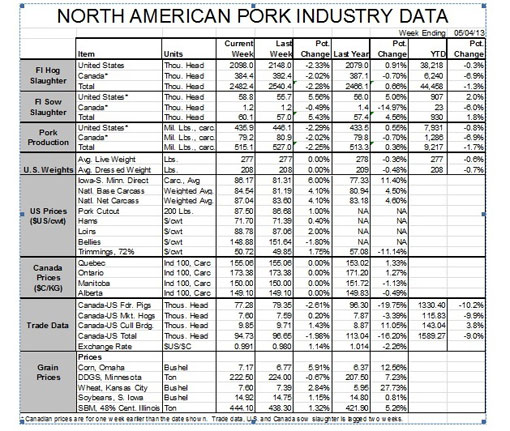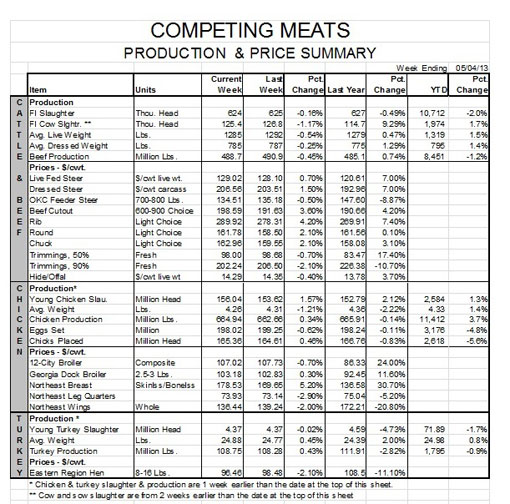



Ractopamine Restrictions Blamed for Pork Export Slump
US - "Choose about any negative word you want – awful, dismal, disastrous, whatever – they can be used to describe the state of pork exports in March. Only Canada and the markets labelled "Other" were higher this March year than last - 7.4 per cent and 16.2 per cent, respectively. All others were lower - some a lot lower!" writes Steve Meyer in his Market Preview published in National Hog Farmer magazine.US pork exports in March amounted to 397.15 million pounds, carcass weight equivalent, according to USDA. That figure is 18.4 per cent lower than one year ago. The decline is the largest year-on-year drop in US pork exports since the summer of 2009. It is no accident that the factor that drove the 2009 slump is the same as this year: import disruptions to Russia and China. In 2009, the reason was, of course, the H1N1 influenza. This year it is ractopamine. Neither reason holds any water from a scientific, consumer health or logic standpoint, but their impacts are very real in economic terms.
As predicted, shipments to Russia in March were zero due to the country’s ban on imports of US beef, pork and turkey. It doesn’t matter that some US processors said they could deliver pork from animals not fed ractopamine. Russia wasn’t interested in our suppliers meeting their stated needs or allaying their stated fears. They were interested in blocking US product from entering the country. It appears the same is true for product from Canada, where a number of suppliers have been barred from exporting to Russia even though they moved quickly to supply pork from non-ractopamine production systems. Russia accounted for 5.1 per cent of US pork exports in 2012.
This type of activity is nothing new for Russia. They played this game with H1N1 in 2009 and then again with tetracycline minimum residue levels (MRLs) in 2010. They have done the same thing with US chicken imports on several occasions, leading Paul Aho of Poultry Perspectives to say, “The US chicken industry has decided that some customers are so bad they are not worth having.”
US chicken companies, of course, still sell chicken to Russia as March year-on-year exports were up 42 per cent, and up 36 per cent for 2013, year-to-date. But they have apparently ceased to count on or cultivate that trade relationship, in effect saying, “We’ll be glad to sell you some product but we’re not including the prospect in our plans.”
A quick perusal of Figure 1 suggests pork producers may have to do the same. There are a lot of monthly observations for exports to Russia that are near or at zero!
China is a different story. Shipments to China/Hong Kong were down 36 per cent, year-on-year in March, but those shipments of 48.2 million pounds carcass weight were only 3.2 per cent lower than in February. While China has made noise about having product “certified” free of ractopamine, Chinese buyers’ – or maybe, more accurately, the Chinese government’s – desire for product from ractopamine-free production is nothing new.
The driver of the negative year-on-year comparisons remains the surge of exports in late 2011 and early 2012. We are still making year-on-year comparisons to very large year-ago numbers. That doesn’t mean that year-to-date exports of just over 140 million pounds carcass weight equivalent (down 42 per cent from last year) are anything to be excited about but we knew something like that was coming. We may all be disappointed but I don’t believe anyone should have been surprised by these numbers.
“Certification” Uncertainty
None of that is meant to discount the challenges associated with “certification” since no one seems to know exactly what “certification” means. The uncertainty becomes a real problem in a world with testing systems that are sensitive to parts per trillion. If the certification standard is zero, that may be very, very difficult to reach. Reaching any unknown number that could be as low as zero, especially if the number is to be determined when the product reaches China, creates a risk that will be viewed as insurmountable by some.
My information is that hogs from ractopamine-free production systems moving through plants that process no ractopamine-fed pigs can meet any reasonable standard China might set. They may even get to zero, but that is a very high standard. A reasonable portion of the US industry has delivered and will continue to deliver pork to China from pigs not fed ractompamine.
I haven’t seen it stated so bluntly, but the ractopamine-free statement ought to have attached to it: “at an appropriate premium.” Consumers, whether from the United States or abroad, have every right to demand any product they want. Want meat from pigs raised in the kitchen? Fine. It won’t be my kitchen, but someone may supply them.
Remember, demand depends on quantity and price. Whether delivering pork from ractopamine-free systems, pork with high levels of marbling, or pork from pigs that have happily romped in mud lots, producers and packers must strive to cover all costs of production.
I hope that restriction is being applied to product going to China and Russia. Maybe we should add another little bit just to compensate for the headache factor.











